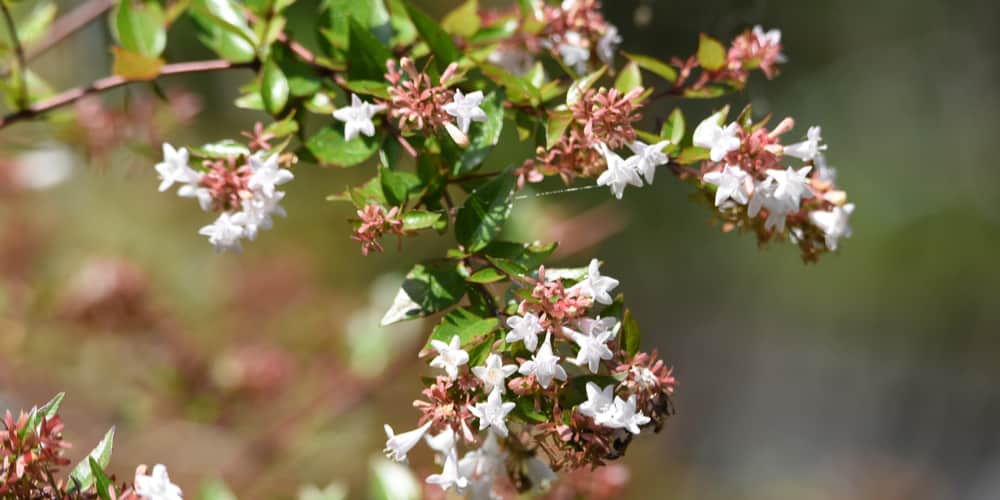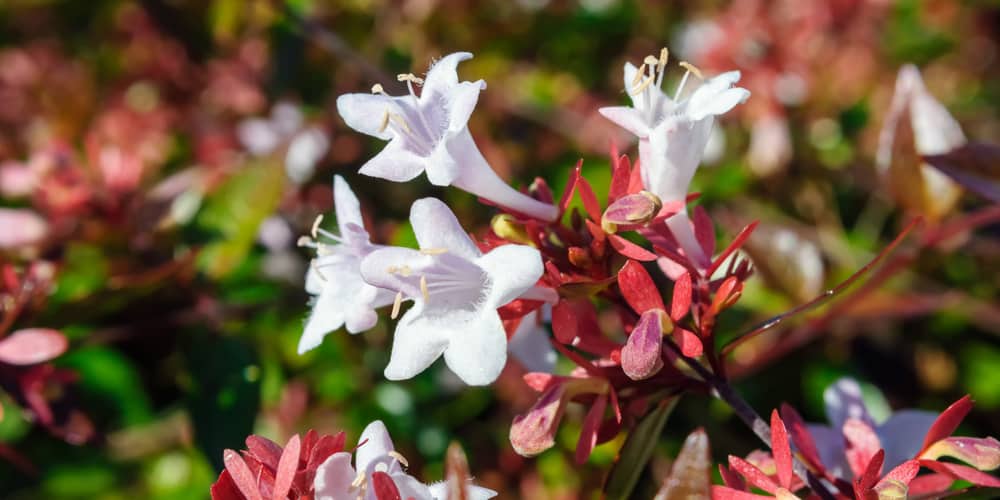Abelia ‘Rose Creek’ is noted for its superbly compact size and showy light pink and white blooms. The flowers are very fragrant and tend to last from spring through fall. Let’s look at how to grow and care for the abelia x grandiflora rose creek.

| Botanical Name | Abelia x Grandiflora Rose Creek |
| Common Name | Rose Creek Abelia |
| Plant Type | Perennial |
| Flower Color | Clusters of white with pink leaf highlights |
| Size When Mature | 36 inches |
| Bloom Time | Spring |
| Sun Requirements | Full sun to partial shade |
| USDA Hardiness Zones | 6 to 9 |
| Soil PH Range | Acidic, Neutral, Alkaline |
| Soil Type | Well-drained with organic matter |
| Water Needs | Medium |
| Native Area | Mexico, East Asia |
What you Need to Know About Abelia Rose Creek
The Abelia Rose Creek is a dwarf cultivar with a compact growth habit and an unforgettable profusion of white blooms forming a cluster. The flowers exude a sweet scent and tend to stick around until the first frost of winter.
The Abelia plant species is easy to grow and can survive drought, erosion and cold winters. The leaves have a pink tinge at first, then turn a shiny dark green over time.
How to Care for Abelia ‘Rose Creek’
Here’s everything you need to know about growing and caring for a thriving Abelia x grandiflora rose creek.
Light
Rose Creek Abelia likes full sun, or areas that provide 6 or more hours of direct sunlight a day but the shrub can grow in locations that get partial shade. It’s worth noting that the more sun it gets the more flowers it produces and the sweeter the scent.
Abelia Rose Creek can grow in a container as long as it gets a sunny window. Rotate a quarter each week to promote an even form or shape.
Water and Soil Needs
‘Rose Creek’, like other Abelias, can grow in any soil medium as long as it doesn’t hold too much moisture. Aside from good drainage, the Rose Creek Abelia needs a lot of nutrients, so amending with organic matter is a must.
Soil pH can range from acidic to alkaline and even neutral. As far as watering is concerned, the plant likes to have evenly moist soil and regular watering, especially on hot days and summer seasons.
Temperature Requirements
Abelia ‘Rose Creek’ thrives in USDA zones 6 to 9 and adopts an evergreen or deciduous characteristic, depending on where it’s planted. Dieback may occur in cold winters, but the hardy shrub will likely start new growth when temperatures rise.
Fertilizer
The best fertilizer to use on an Abelia x grandiflora rose creek is organic. Make sure to amend the soil with plenty of organic matter, such as mulch or manure before planting Abelia ‘Rose Creek’ so it can get a nice head start.
Fertilizing during the growing season will make Rose Creek Abelia produce more blooms. During this time, greater sun exposure is also recommended.
Common Diseases
Rose Creek Abelia is not prone to any particular pest or disease, but it may occasionally suffer from an aphid attack. This can be easily remedied early and once spotted by removing the pests by hand or with a well-aimed jet of water from the hose.
Abelia x grandiflora rose creek Propagation
You can easily multiply your Abelia Rose Creek plants with cuttings taken from mid-summer to early fall. Choose ones that have around three to four leaf nodes and are healthy for a higher chance of success.
Take several semi-hardwood cuttings and submerge the bottom leaf nodes in a well-draining and moist medium. Water only occasionally and when the soil is completely dry. After several weeks, you should start to see new growth.
Transplant to a bigger container or in the garden after a month or when the roots have grown 3 to 4 inches long.

